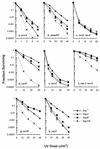Escherichia coli strains lacking protein HU are UV sensitive due to a role for HU in homologous recombination
- PMID: 9683467
- PMCID: PMC107354
- DOI: 10.1128/JB.180.15.3750-3756.1998
Escherichia coli strains lacking protein HU are UV sensitive due to a role for HU in homologous recombination
Abstract
hupA and hupB encode the alpha and beta subunits of the Escherichia coli histone-like protein HU. Here we show that E. coli hup mutants are sensitive to UV in the rec+ sbc+, recBC sbcA, recBC sbcBC, umuDC, recF, and recD backgrounds. However, hupAB mutations do not enhance the UV sensitivity of resolvase-deficient recG ruvA strains. hupAB uvrA and hupAB recG strains are supersensitive to UV. hup mutations enhance the UV sensitivity of ruvA strains to a much lesser extent but enhance that of rus-1 ruvA strains to the same extent as for rus+ ruv+ strains. Our results suggest that HU plays a role in recombinational DNA repair that is not specifically limited to double-strand break repair or daughter strand gap repair; the lack of HU affects the RecG RusA and RuvABC pathways for Holliday junction processing equally if the two pathways are equally active in recombinational repair; the function of HU is not in the substrate processing step or in the RecFOR-directed synapsis action during recombinational repair. Furthermore, the UV sensitivity of hup mutants cannot be suppressed by overexpression of wild-type or mutant gyrB, which confers novobiocin resistance, or by different concentrations of a gyrase inhibitor that can increase or decrease the supercoiling of chromosomal DNA.
Figures



Similar articles
-
Involvement of RecF pathway recombination genes in postreplication repair in UV-irradiated Escherichia coli cells.Mutat Res. 1994 Jul;315(1):1-9. doi: 10.1016/0921-8777(94)90021-3. Mutat Res. 1994. PMID: 7517004
-
Resolution of Holliday intermediates in recombination and DNA repair: indirect suppression of ruvA, ruvB, and ruvC mutations.J Bacteriol. 1993 Jul;175(14):4325-34. doi: 10.1128/jb.175.14.4325-4334.1993. J Bacteriol. 1993. PMID: 8331065 Free PMC article.
-
The RuvABC resolvase is indispensable for recombinational repair in sbcB15 mutants of Escherichia coli.J Bacteriol. 2002 Aug;184(15):4141-7. doi: 10.1128/JB.184.15.4141-4147.2002. J Bacteriol. 2002. PMID: 12107131 Free PMC article.
-
Histone-like protein HU is required for recA gene-dependent DNA repair and SOS induction pathways in UV-irradiated Escherichia coli.Int J Radiat Biol. 2000 Jan;76(1):43-9. doi: 10.1080/095530000138998. Int J Radiat Biol. 2000. PMID: 10665956
-
Processing of Holliday junctions by the Escherichia coli RuvA, RuvB, RuvC and RecG proteins.Experientia. 1994 Mar 15;50(3):216-22. doi: 10.1007/BF01924004. Experientia. 1994. PMID: 8143795 Review.
Cited by
-
The HU protein is important for apicoplast genome maintenance and inheritance in Toxoplasma gondii.Eukaryot Cell. 2012 Jul;11(7):905-15. doi: 10.1128/EC.00029-12. Epub 2012 May 18. Eukaryot Cell. 2012. PMID: 22611021 Free PMC article.
-
The Escherichia coli histone-like protein HU has a role in stationary phase adaptive mutation.Genetics. 2007 Oct;177(2):723-35. doi: 10.1534/genetics.107.075861. Epub 2007 Aug 24. Genetics. 2007. PMID: 17720921 Free PMC article.
-
Structure-based analysis of HU-DNA binding.J Mol Biol. 2007 Jan 26;365(4):1005-16. doi: 10.1016/j.jmb.2006.10.024. Epub 2006 Oct 13. J Mol Biol. 2007. PMID: 17097674 Free PMC article.
-
The HU regulon is composed of genes responding to anaerobiosis, acid stress, high osmolarity and SOS induction.PLoS One. 2009;4(2):e4367. doi: 10.1371/journal.pone.0004367. Epub 2009 Feb 4. PLoS One. 2009. PMID: 19194530 Free PMC article.
-
Nucleoid-Associated Protein HU: A Lilliputian in Gene Regulation of Bacterial Virulence.Front Cell Infect Microbiol. 2019 May 10;9:159. doi: 10.3389/fcimb.2019.00159. eCollection 2019. Front Cell Infect Microbiol. 2019. PMID: 31134164 Free PMC article. Review.
References
-
- Bensaid A, Almeida A, Drlica K, Rouviere-Yaniv J. Cross-talk between topoisomerase I and HU in Escherichia coli. J Mol Biol. 1996;256:292–300. - PubMed
-
- Bonnefoy E, Takahashi M, Rouviere-Yaniv J. Quantitative determination of DNA-binding parameters show a specific interaction of the HU protein of Escherichia coli to cruciform DNA. J Mol Biol. 1994;242:116–129. - PubMed
-
- Brendel M, Haynes R H. Interactions among genes controlling sensitivity to radiation and alkylation in yeast. Mol Gen Genet. 1973;125:197–216. - PubMed
-
- Castaing B, Zelwer C, Laval J, Boiteux S. HU protein of Escherichia coli binds specifically to DNA that contains single-strand breaks or gaps. J Biol Chem. 1995;270:10291–10296. - PubMed
Publication types
MeSH terms
Substances
LinkOut - more resources
Full Text Sources
Other Literature Sources
Miscellaneous

